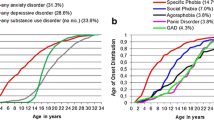Summary
In the last decade anxiety disorders have been the focus of intensive research in the psychiatric community, resulting in a rapid growth in our understanding of these illnesses. Diagnostic, biological, and psychopharmacological investigations have revealed important distinctions among these disorders which enable the clinician to make well- informed therapeutic choices and frequently ameliorate or even eliminate anxiety symptoms and related phobic behaviour. The principles of treatment can be simply stated:
-
1.
Careful diagnostic evaluation through history and exclusion of medical and psychiatric conditions which mimic anxiety disorders.
-
2.
Treatment selection based on diagnosis and formulation with the patient of the goals and expected outcome of pharmacotherapy.
-
3.
Systematic application of each drug treatment in sufficient dosage and for an adequate duration permitting progression to the next agent when results are not optimal.
-
4.
Addition of non- pharmacological interventions, usually behavioural therapy, to decrease phobic behaviour.
-
5.
Development of a maintenance or discontinuation strategy tailored to the needs of the patient.
Similar content being viewed by others
References
Brier A, Charney DS, Nelson JC. Seizures induced by abrupt withdrawal of alprazolam. American Journal of Psychiatry 141: 1606–1607, 1984
Feighner JP, Herbstein J, Damlouji N. Combined MAOI, TCA, and direct stimulant therapy of treatment-resistant depression. Journal of Clinical Psychopharmacology 46: 206–209, 1985
Gorman JM, Fyer AJ, Gliklich J, et al. Mitral valve prolapse and panic disorders: effects of imipramine. In Klein et al. (Eds) Anxiety — new research and changing concepts, Raven Press, New York, 1981
Gorman JM, Levy GF, Liebowitz MR, et al. Effect of acute beta-adrenergic blockade on lactate-induced panic. Archives of General Psychiatry 40: 1079–1083, 1984a
Gorman JM, Liebowitz MR, Fyer AJ, et al. Treatment of social phobia with atenolol. Journal of Clinical Psychopharmacology 5: 298–301, 1985
Gorman JM, Martinez JM, Liebowitz MR, et al. Hypoglycemia and panic attacks. American Journal of Psychiatry 141: 101–104, 1984b
Insel TR, Hamilton JA, Guttmacher LB, et al. D-amphetamine in obsessive-compulsive disorder. Psychopharmacology 80: 231–235, 1983
Klein DF. Delineation of two drug-responsive anxiety syndromes. Psychopharmacologia 5: 397–408, 1964
Klein DF. Anxiety reconceptualized. In Klein et al. (Eds) Anxiety — new research and changing concepts, Raven Press, New York, 1981
Liebowitz MR, Gorman JM, Fyer AJ, et al. Social phobia: review of a neglected disorder. Archives of General Psychiatry 42: 729–736, 1985
Liebowitz MR, Quitkin FM, Stewart JW, et al. Phenelzine versus impramine in atypical depression. Archives of General Psychiatry 41: 669–677, 1984
Marks IM, Stern RS, Mawson D, et al. Clomipramine and exposure for obsessive-compulsive rituals. British Journal of Psychiatry 136: 1–25, 1980
Noyes R, Anderson DJ, Clancy J, et al. Diazepam and propranolol in panic disorder and agoraphobia. Archives of General Psychiatry 41: 287–292, 1984
Shader RI, Greenblatt DJ. Editorial. Journal of Clinical Psychopharmacology 4: 1, 1984
Sheehan DV, Ballenger J, Jacobsen G. Treatment of endogenous anxiety with phobic, hysterical, and hypochondriacal symptoms. Archives of General Psychiatry 37: 51–59, 1980
Sheehan DV, Coleman JH, Greenblatt DJ, et al. Some biochemical correlates of panic attacks with agoraphobia and their response to a new treatment. Journal of Clinical Psychopharmacology 4: 66–75, 1984
Thoren P, Asberg M, Cronholm B, et al. Clomipramine treatment of obsessive-compulsive disorder. I. A controlled trial. Archives of General Psychiatry 37: 1381–1385, 1980
Uhde TW, Vittone BJ, Post RM. Glucose tolerance testing in panic disorder. American Journal of Psychiatry 141: 1461–1463, 1984
White K, Simpson G. Combined MAOI-tricyclic antidepressant treatment: a reevaluation. Journal of Clinical Psychopharmacology 1: 264–282, 1981
Zitrin CM, Klein DF, Woerner MG, et al. Treatment of phobias. I. Comparison of imipramine hydrochloride and placebo. Archives of General Psychiatry 40: 125–138, 1983
Author information
Authors and Affiliations
Rights and permissions
About this article
Cite this article
Levin, A.P., Liebowitz, M.R. Drug Treatment of Phobias. Drugs 34, 504–514 (1987). https://doi.org/10.2165/00003495-198734040-00004
Published:
Issue Date:
DOI: https://doi.org/10.2165/00003495-198734040-00004




